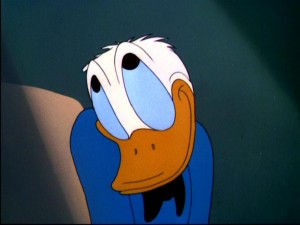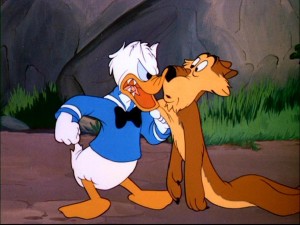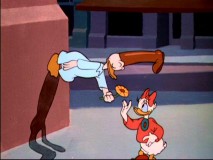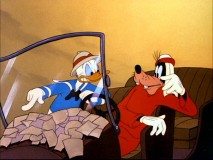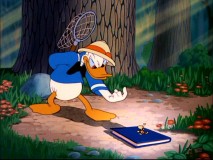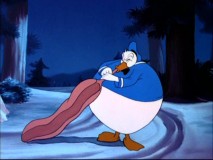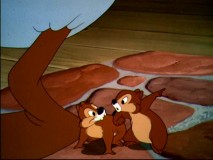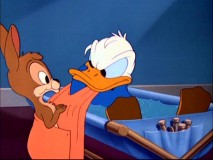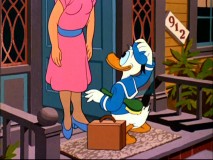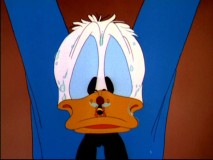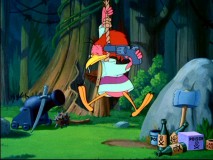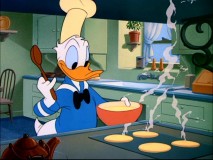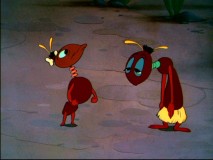Donald Duck Cartoon Shorts on DVD - The Chronological Donald: Volume One • Volume Two • Volume Three • Volume Four
The Chronological Donald Volume 3 DVD Review
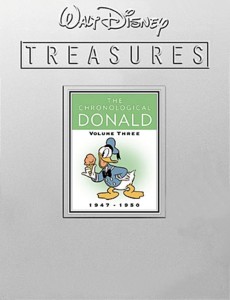 |
Disc 1: 16 Donald Duck Shorts (Click title to view that portion of the review)
|
Page 1: Set Overview and Disc 1 Shorts Page 2: Disc 2 Shorts, Video & Audio, Bonus Features, and Closing Thoughts |
Of Disney's classic Fab Five characters (or the Spectacular Six if you include the often-ignored Daisy), Donald Duck is arguably the most popular. Mickey, of course, will always be the most recognizable due to him being an iconic status symbol, but Donald tends to be the character most people cite as their favorite. As Mickey grew into the Disney figurehead, the studio's animators became much more aware of what sort of situations to put him in. The bad boy antics of his early days no longer seemed to sit well with the character meant to represent the company, What's interesting to note about the cartoons featured here is how Donald's role slowly morphs throughout this three-year span. He starts off being the star of his shorts, propelling the action forward and dealing with various everyday situations in his own way. Eventually, though, it seems like the story people were running out of ideas and predicaments to place him in. They repeatedly tried to bring in supporting characters that would essentially upstage Donald similarly to how he upstaged Mickey. Two of these characters -- the Bootle Beetle and Buzz-Buzz the bumblebee -- only appeared a handful of times. One pair of characters did manage to stick, though: these were fast-chattering chipmunk duo Chip 'n Dale. Many of the shorts in this collection follow the same formula: Chip and Dale attempt to steal a food item of Donald's, which the short-tempered Duck does not take lightly. While this admittedly grew a bit stale after a while, it managed to secure Chip and Dale a place in Disney's hall of fame.
Even with a frequent formula, Donald's shorts from this era stand out as some of his very best. This is due to two factors, the first being the creativity of both the animators and the story department. Many rapid-fire visual gags come across as inspired and are given just the right timing to make them amusing. It's obvious that the team responsible for these shorts was confident in what it was doing. The other reason these shorts are so memorable is the sound design. Donald Duck may be the most mean-spirited and aggresive of the classic Disney personalities, but this actually makes him more relatable to the audience. He's someone who vents the sort of frustrations many people wish to but don't out of civility. The shorts he starred in from 1947-50 exemplify why he still resonates with both old and new generations. They're timeless, creative, and feature humor that transcends any sort of language barrier (including Donald's own warbling).
PACKAGING The packaging of the Walt Disney Treasures line immediately illustrates what a particularly special collection this is. The Chronological Donald, Volume Three adds to this tradition. Instead of the usual standard-size Alpha keepcase, a double-wide black Alpha case is used, and it is held inside of an embossed tin. As with the past couple of waves, Donald and the two sets accompanying it have no outer band featuring the copy number or Roy Disney's signature. These are both found on the certificate of authenticity inside the case. The other in-case inclusions are plenty familiar to buyers of this series: an 8-page booklet discussing the set and its contents, and a miniature lithograph. The litho in question reproduces the poster art for 1947's Inferior Decorator. While the two sets released concurrently with Donald featured an additional bonus keepsake, this one does not. DISC 1 A somewhat out of place trailer for the Pixar Short Films Collection, Volume 1 starts off the disc. This is followed by the expected introduction from Leonard Maltin (2:16) explaining Donald's career history and the type of shorts to be found on this disc. THE SHORTS
Straight Shooters (1947) (6:12)
Sleepy Time Donald (1947) (6:31)
Donald's Dilemma (1947) (7:15)
Crazy with the Heat (1947) (6:00)
Bootle Beetle (1947) (7:01)
Wide Open Spaces (1947) (6:37)
Chip 'An Dale (1947) (6:38)
Drip Dippy Donald (1948) (6:45)
Daddy Duck (1948) (6:34)
Donald's Dream Voice (1948) (6:28)
The Trial of Donald Duck (1948) (6:48)
Inferior Decorator (1948) (6:20)
Soup's On (1948) (6:53)
Order Walt Disney Treasures: The Chronological Donald, Volume Three from Amazon.com
|
